*FYI - this post may contain affiliate links, which means we earn a commission at no extra cost to you if you purchase from them. Also, as an Amazon Associate I earn from qualifying purchases. Check out our Privacy Policy and Disclosure. for more info.
If your dumpling imagination is limited only to gyoza or dim sum classics, well my friend, it’s time to expand your horizons because the world is wide and filled with dumplings… all of which are awaiting your discovery, dolla’ bills, and caloric regret.
See, the wonderful thing about dumplings is their chameleon-esque ability to adapt to regional tastes and traditions, creating a precious comfort food that transcends cultural barriers. Name a place and it probably has its own version of a dumpling, making it (in my mind) the most delicious symbol of global unity.
So, what do dumplings look like around the world? Here we are… a great dumpling bucket list. Scroll at your own risk. Hunger and drool puddles await.

A Note on What I Consider a “Dumpling”
Let’s start this post with a confusing, philosophical question.
What makes something a dumpling anyway?
I will let you guys fight this out in the comments, because let’s be honest, some of you are just waiting with flour-dusted torches to pounce and inform me “this or that isn’t a dumpling” or “why did you create a blog about dumplings” or “is this why your friends don’t invite you to things”?
Well, MOM, I have to say the exact definition of dumpling varies depending on who you ask, but for my purpose, I define a dumpling simply as a blob of bite-sized dough, regardless of its filling (stuffed or not) and means of preparation (whether steamed, fried, boiled or baked).
So, here is a list of dumplings from around the world… starting with Asia! Let me know in the comments if I’ve missed any of your favourites so I can check them out.
Droolworthy Asian Dumplings You Wonton Your Bucket List
From tasty East Asian favourites like gyoza and jiaozi to yummy South Asian dumplings like aushak and samosas, here is a tasty list of Asian dumplings you need to try at least once in your lifetime.
Jiaozi
Jiaozi is a broad term used for the ever-popular Chinese dumplings composed of ground meat or veggies encased in a thin flour-based skin.
While they’re commonly consumed around Chinese New Year, their popularity has made them a staple appetizer in Chinese restaurants around the world, with countless variations across regions and cultures.
Jiaozi can be prepared in a variety of ways, including boiled, steamed, fried, or even steam-fried (like in addictive potstickers!). Needless to say, this might be the first image that comes to mind for most when they imagine dumplings, and your life is not complete until you’ve stuffed your face with a few.
Recommended reads:
- My Foolproof Chinese Pork Dumpling Recipe
- What to Serve with Chinese Dumplings & Potstickers
- My Best Dumpling Puns
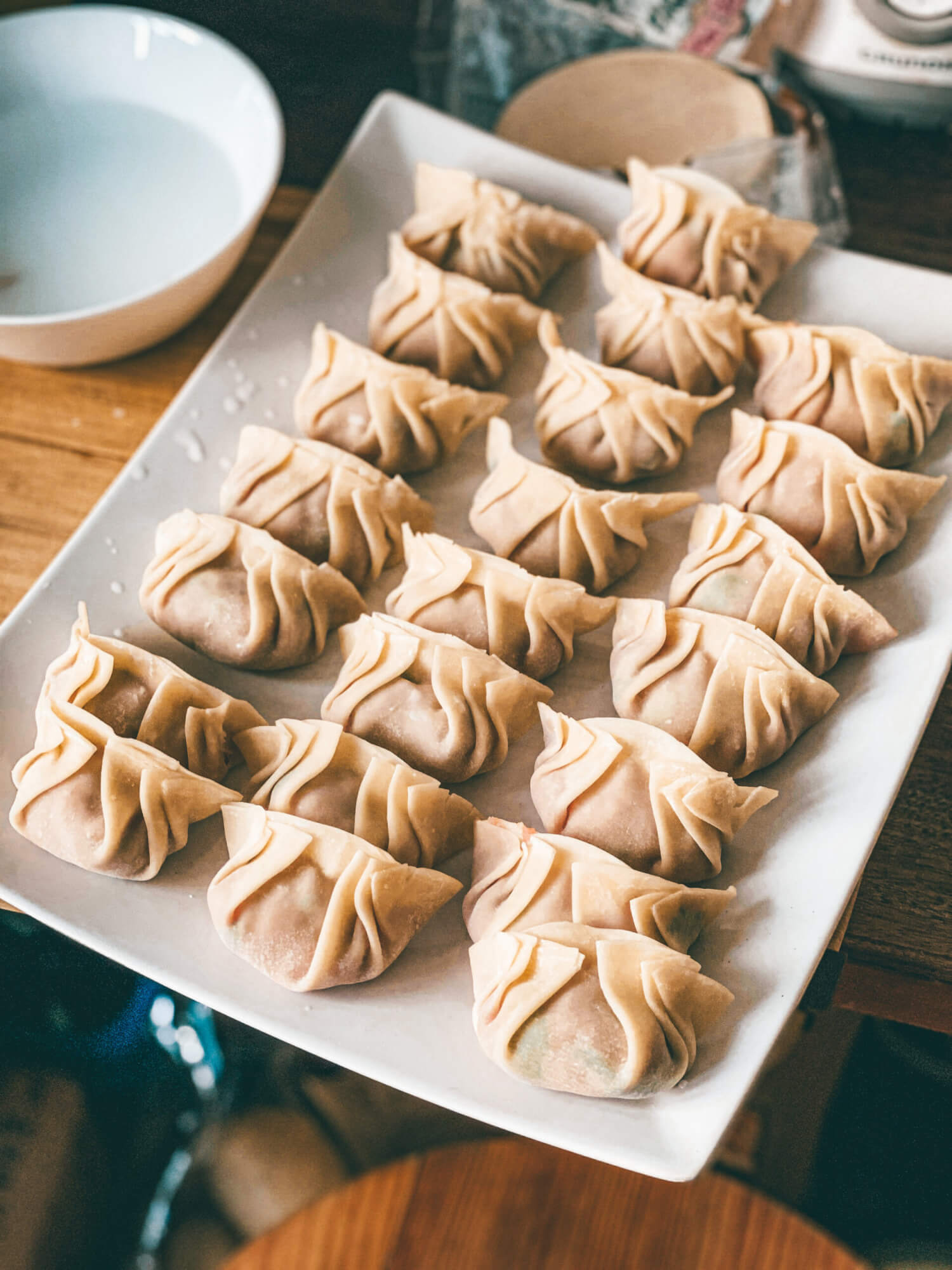
Har Gow
Har Gow (sometimes spelled Ha Gow) are a wonderful Cantonese dumpling comprised of a juicy shrimp filling and a thin, translucent skin made from tapioca and wheat starch.
These cute little shrimp bonnets are then steamed to perfection in a traditional bamboo steamer and liberally shoved into the mouths of hungry hungry Christinas.
This is probably one of the most famous and important foods in dim sum, with a distinctive pleated look that makes it as adorable as it is delicious.
Growing up in a Cantonese household, these have always been my favourite dumplings to eat (and make dim sum puns about).
I have since converted my boyfriend and countless friends over the years.
Har Gow are a must-try, trust me…

Shumai
Another popular dim sum treat you need on your bucket list is Shumai, an open-faced dumpling usually made up of ground pork, mushrooms, shrimp, or bamboo shoots in some combination.
Wrapped by a delicate wonton-like wrapper that houses the filling in a tasty lil bowl, its distinctive final touch is typically a crown of fish roe or a pea to complete the picture.
The end result is of course a bite of perfection, and a must-try for any dumpling lover.

Fun Guo
While not as popular by name as its sister-dumpling, Har Gao, Fun Guo is an equally delicious Chinese dumpling of Cantonese origins that you should try at least once!
These pork dumplings are covered in the same addictive and translucent skin as Har Gao, but are traditionally filled with pork, mushroom and chives. Be sure to add some of these to your next dim sum line-up – you won’t regret it.

Gyoza
Gyoza are tasty dumplings from Japan that are now ubiquitous on Japanese restaurant menus around the world.
While undoubtedly similar to Jiaozi in that they consist of meat/veggie fillings wrapped with a thin wrapper, Gyoza tend to have a thinner wrapper and are usually smaller overall, with a thinner more oblong shape.
Some also argue that gyozas place more emphasis on their filling than other dumpling types, making use of finely chopped ingredients like ground pork, chives, and cabbage.
Of course, given the various ways that gyoza can be prepared depending on where you are, a lot of gyoza will closely resemble their Chinese counterparts, and vice versa.
In fact, gyoza’s origins come from China, when Japanese soldiers were stationed during World War II and created their own version of jiaozi upon returning home.

Wontons
Wontons are plump and delicious Chinese dumplings known for their distinctive square wrapper and tasty pork/shrimp filling.
Most commonly boiled and served in broth (noodles optional but highly encouraged), wontons can also be deep fried and enjoyed with dipping sauce, as has become extremely popular as an appetizer in Chinese restaurants around the world.

Baozi
Long story short: baozi refer to yeasty, bread-like dumplings that are found in infinite varieties throughout Asian cuisine.
Honestly speaking, bao in general is SUCH a broad category, but if I wrote out every kind of bao you need to try on your life, well… this list would literally never end (and neither would your weight gain).
Because “bao” literally translates to buns, these goodies are often known as buns as well, with some of the most popular variations including cha siu bao (filled with BBQ pork), sheng jian bao (filled with juicy pork and steam-fried), and variations of gua bao, the very popular open-faced buns that are stuffed with various fillings in a sort of steamy, pillow-like taco.
Recommended reads:
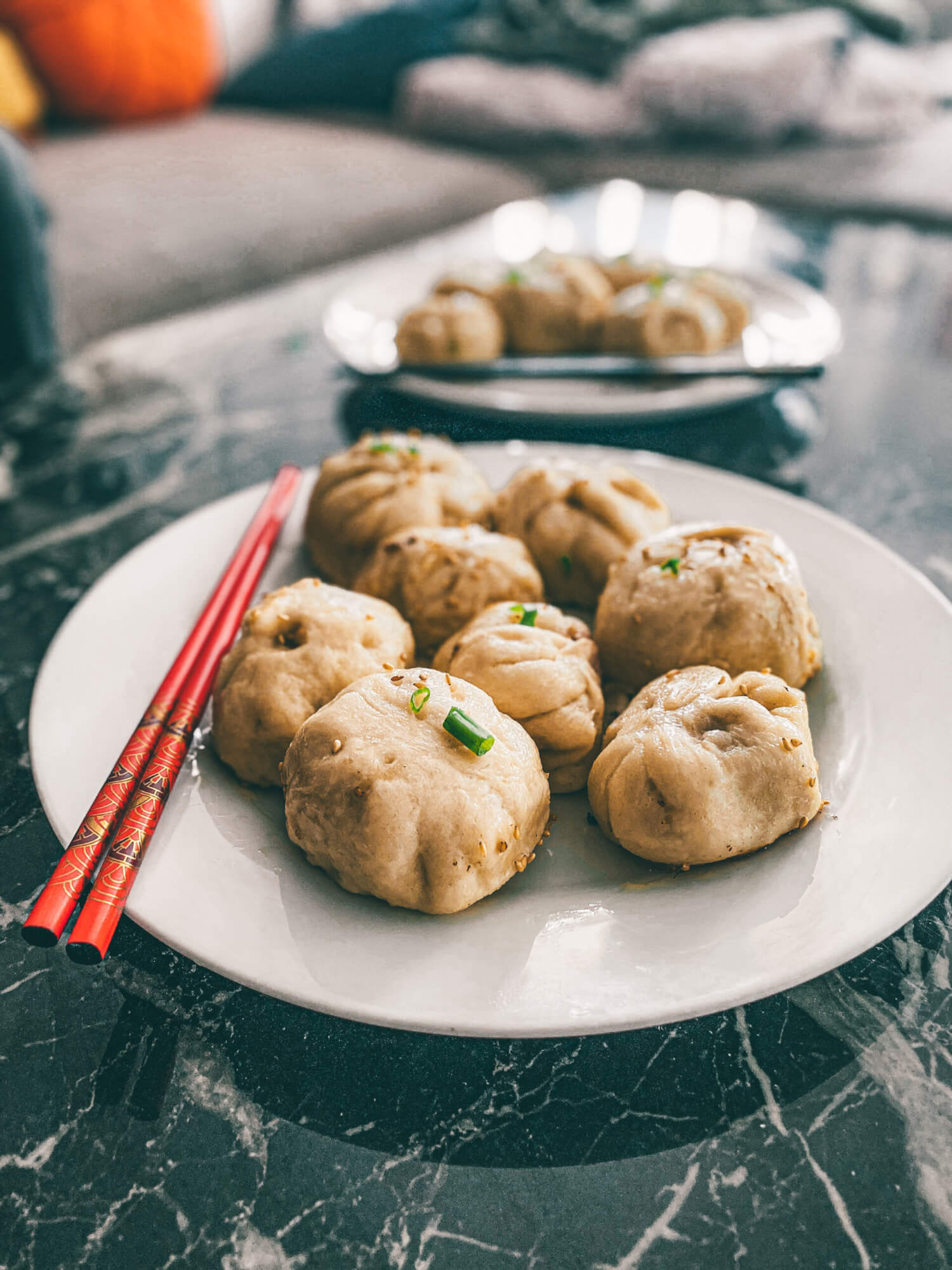
Xiao Long Bao
Also known around the world as soup dumplings, I consider Chinese Xiao Long Bao to be among the most perfect bites in the entire world – nay, perhaps the universe! Imagine a thin dough wrapper encasing a gingery ground meat filling with a secret river of hot savoury broth lurking inside. Eaten without caution, these bad boys are sure to scald your mouth, but trust me when I say they’re worth it. These slurptastic dumplings may indeed be the most addictive dumplings on this list….
NOTE: Xiao Long Bao are part of a broader category of soup-filled dumplings known as Tangbao (literal translation: soup dumpling) which exist in many varieties across China.

Mandu
Mandu are Korean dumplings that can be enjoyed in a variety of ways, including grilled/fried (gun-mandu), steamed (jjin-mandu) and boiled (mul-mandu).
Made up of a flour wrapper and a meat or veggie filling, Mandu is a term encompasses a broad spectrum of tasty dumplings that are served and filled in all kinds of different ways depending on where you are in Korea.
Fillings can vary from your usual suspects such as ground pork/beef to more unique fillings like kimchi, shredded cucumber or fish. There’s one consistency among all mandu varieties though: they’re mighty delicious.

Momo
Momos are a South Asian favourite comprised of steamed dumplings filled with various meats, vegetables and even cheese, depending on where you’re enjoying them. Often accompanied with a chutney or a spiced tomato sauce, these dumplings are as addictive as they are delicious.

Samosas
Indian samosas are fried/baked pastry pockets filled with a variety of tasty fillings such as potatoes, onions, meat, cheese, lentils, or peas. I consider them to be one of the most perfect handheld foods in the world, and while they’re not often considered dumplings, I had to conclude them in this list… they are dough-wrapped deliciousness after all!
Samosa fillings vary across regions, but the most typical variation seen in Indian restaurants around the world is the reliable combo of spiced potato, onions and peas. Non-negotiable of course is the crispy pastry that envelops it all into the samosa’s distinctive triangular shape. These amazing inventions can be found all around the world, and are a must try!
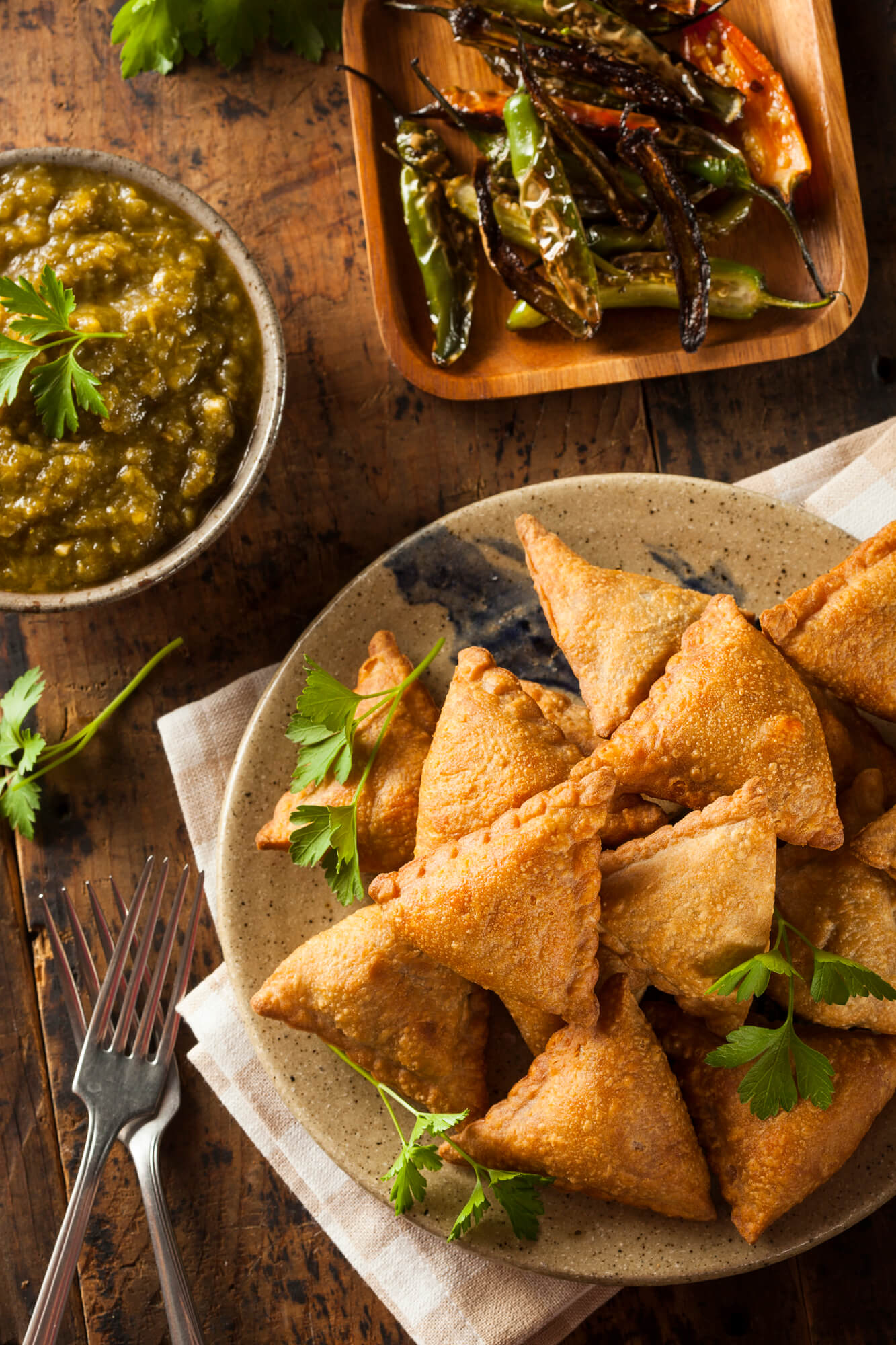
Aushak
Aushak are savoury little dumplings from Afghanistan with a thin skin and a filling made up of either gandana (Afghan leek), or scallions and chives. These packets of perfection are usually served with a hearty topping of meaty tomato sauce and a glob of fresh minty yogurt for balance.
Ba-Wan
Ba-Wan are a beloved Taiwanese street food that mix sweet and savoury flavours with a distinctive chewy texture that’s impossibly addictive. The unique texture of these dumplings is thanks to its mix of sweet potato/rice flour, which creates a gelatinous wrapping for the savoury mix of pork, bamboo and mushrooms waiting inside.
Traditionally, they are served steamed and topped with a sweet and savoury sauce. Yup – this is a snack all about the flavour combos!
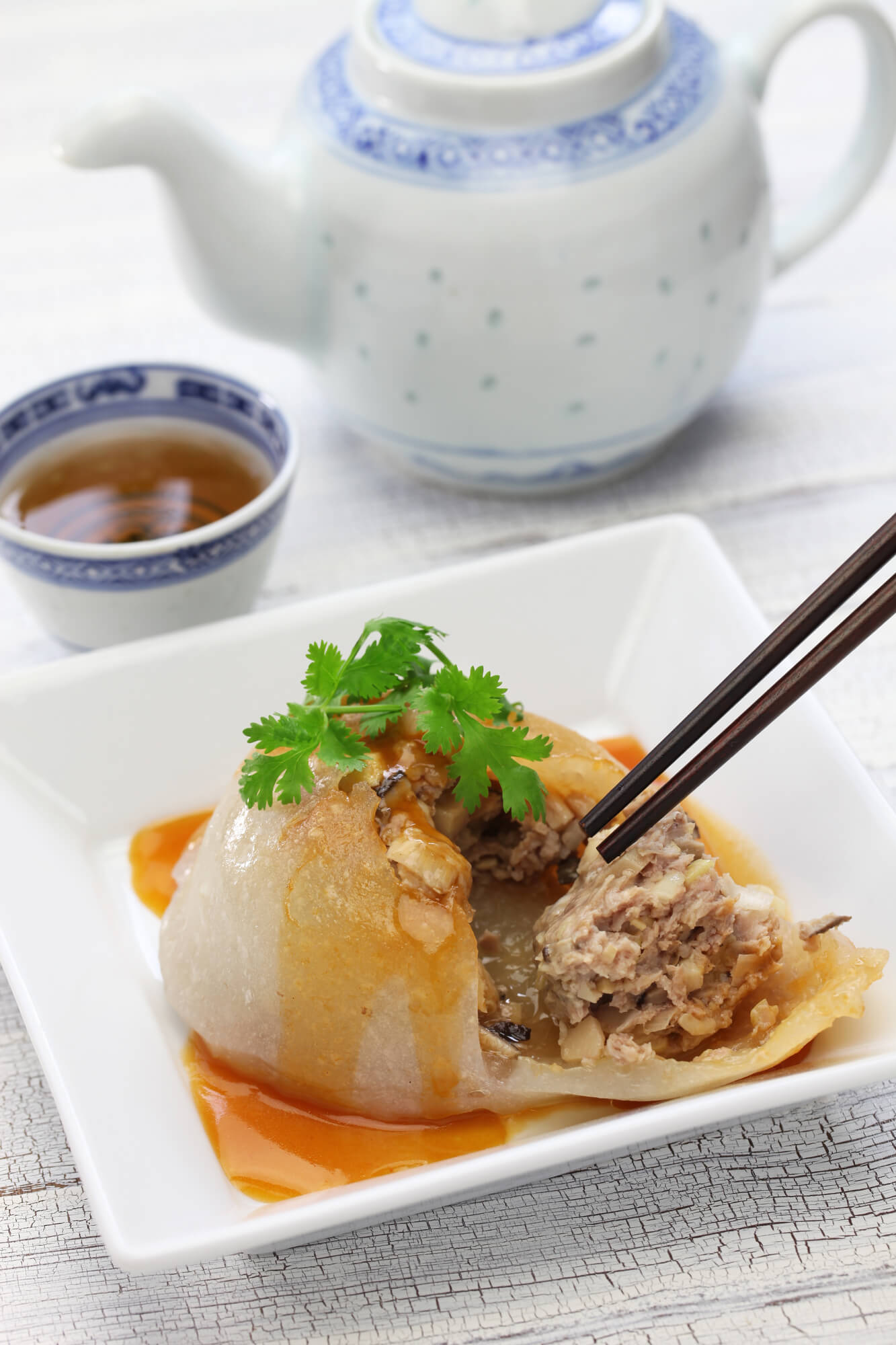
Buuz, Bansh, and Khuushuur
As you might have noticed by now, dumplings are seen in vast variety throughout Asia, and Mongolia is no exception. Here, the simple combination of a minced meat filling (with plenty of onions and garlic) encased in a yummy dough is prepared in different ways, giving rise to three distinct dumplings differentiated by their size and how they’re cooked: Buuz (steamed), Bansh (boiled) and Khuushuur (fried).
Which way is best? You’ll probably need to “test” them all just to be sure…

Cho Muang
Possibly the most aesthetically pleasing dumpling on this list is Cho Muang, a Thai dumpling with a rice & tapioca flour wrapper and sweet or savoury filling… also colloquially known as the Thai flower dumpling.
The reason for this name is simple: these beautiful dumpling creations look like actual flowers! Thanks to dutiful preparation and creative dyes such as butterfly pea flowers, these dumplings are usually presented in gorgeous flower formation, with a vivid blue/purple hue. Unsurprisingly, these beautiful bites have royal origins, and date all the way back to the 18th century.
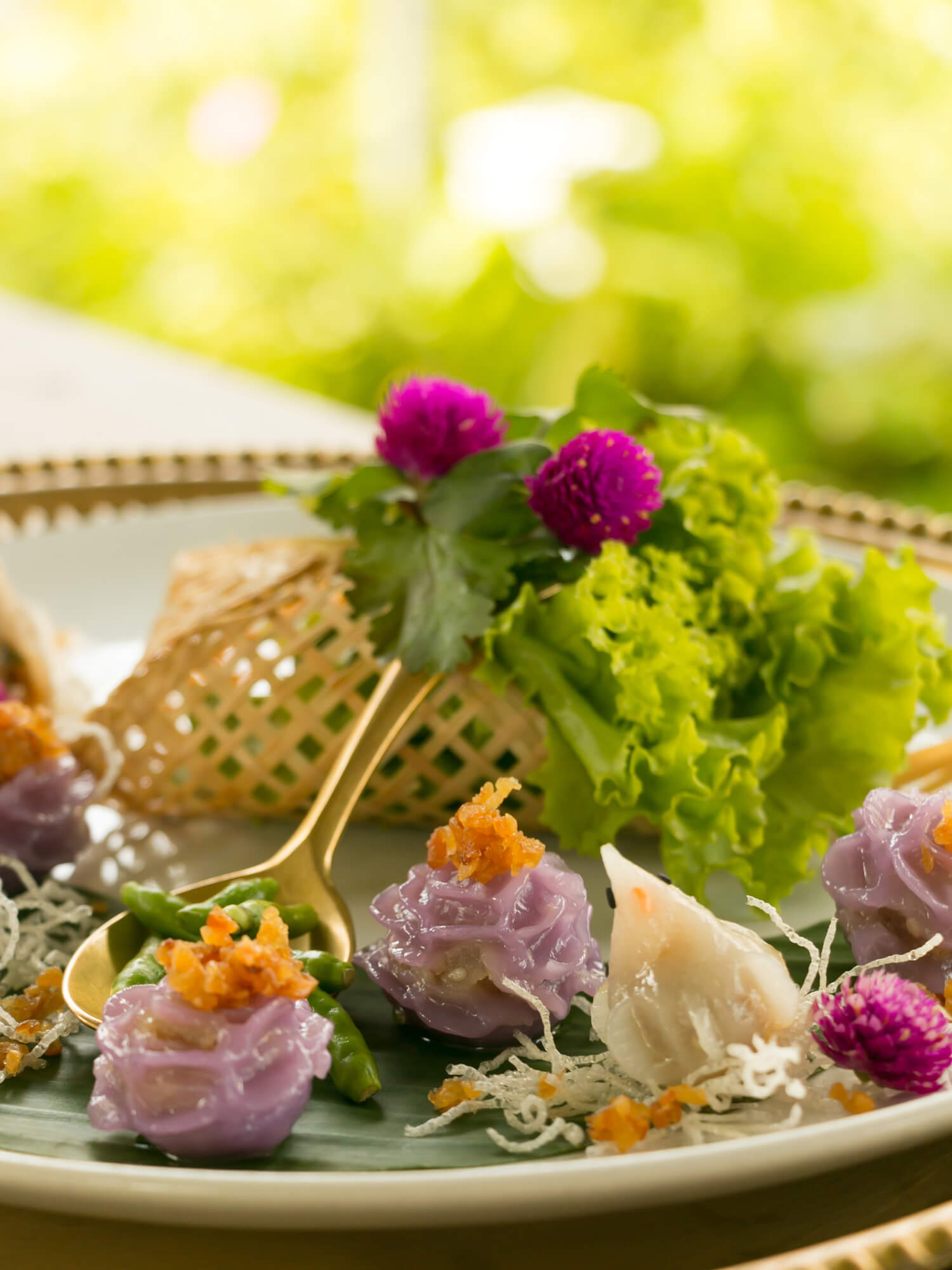
Gujia
Gujia are dessert dumplings from India known for their crispy deep-fried outer layer and sweet filling made of dried fruits, nuts and milk solids such as mhawa and khoya.
These decadent crescent-shaped desserts take on regional variations like many of the world’s most popular dumplings, but it’s a treat especially popular during Holi, an ancient Hindu spring festival known for its colourful celebrations.
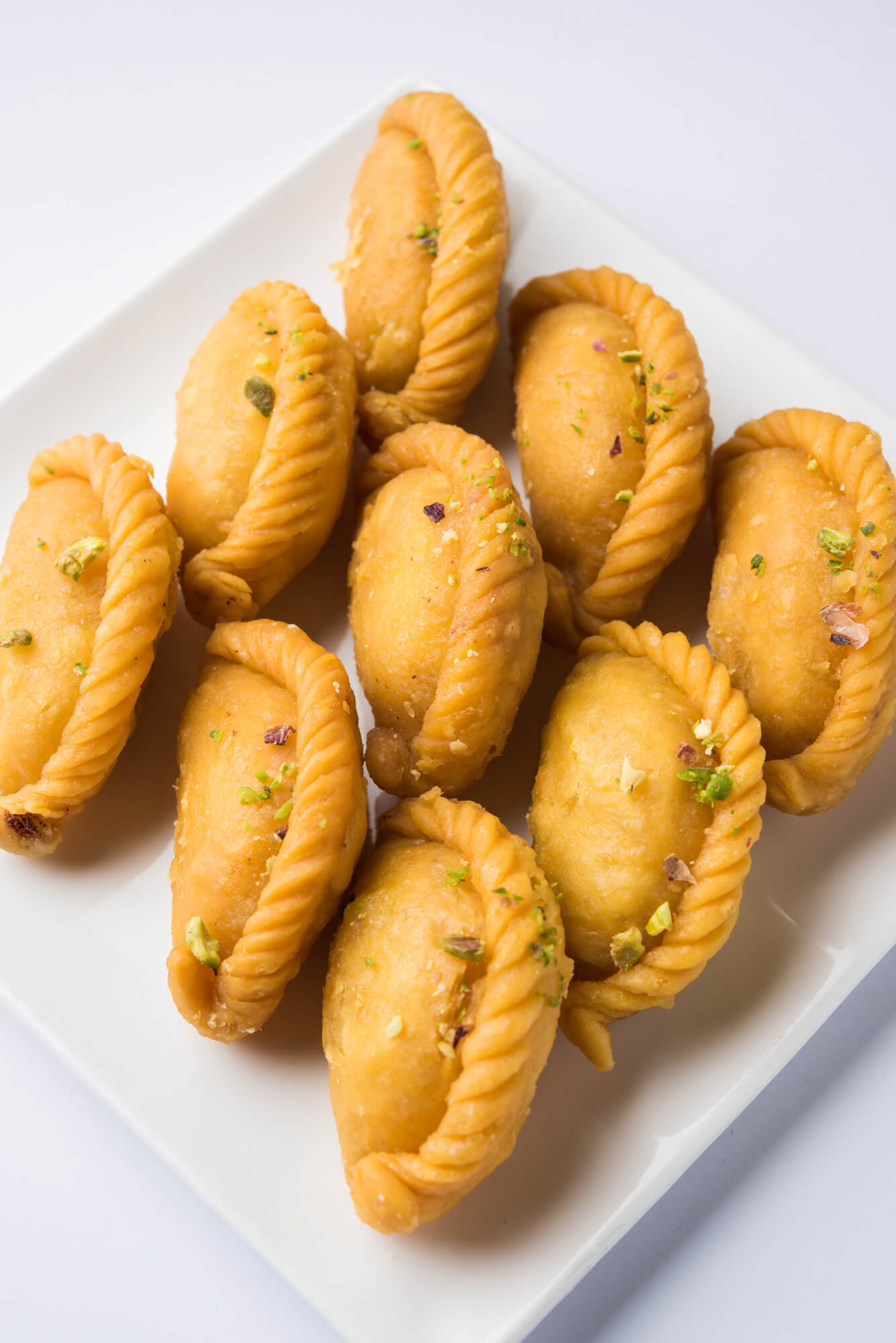
Kozhukkatta
Kozhukkatta are South Indian rice dumplings made from rice flour with a (typically) sweet filling made up of coconut and jaggery, although savoury variations have been known to impress.
These treats are especially popular during religious holidays, and are often used as offerings during Vinayaka Chathurthi (in Tamil Nadu) and consumed on Palm Sunday (in Kerala).
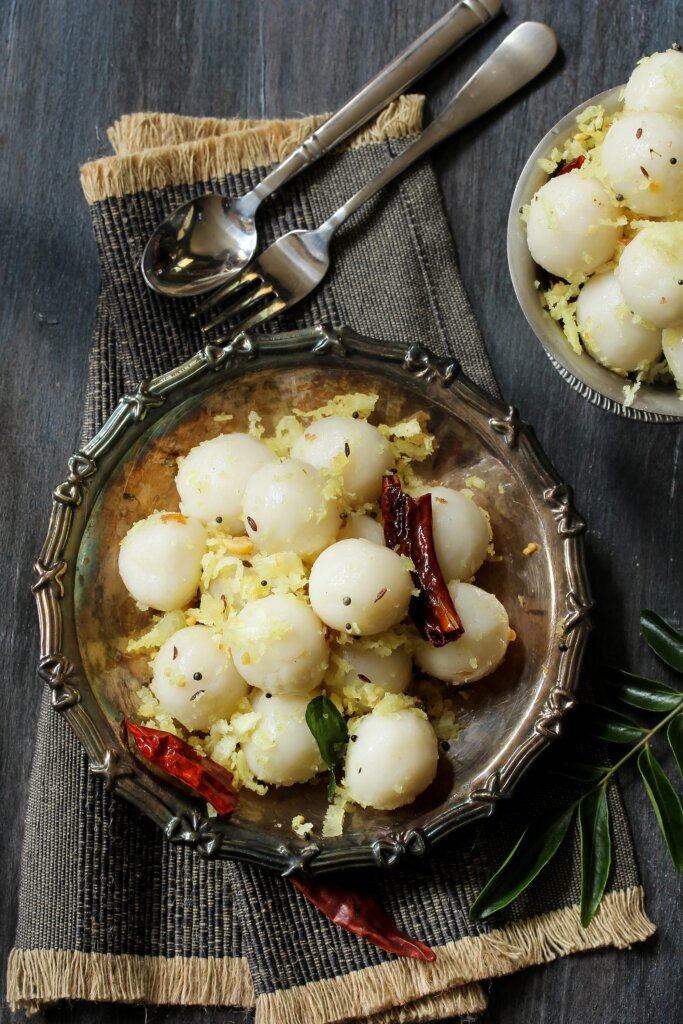
Pundi
As a die hard fan of dumplings and rice, it’s no surprise that the Indian specialty of Mangalorean Pundi (rice dumplings) made this list.
These rounded balls of rice are often served for breakfast with a side of sweet coconut chutney. Sounds like the perfect breakfast, if you ask me.
Pempek
Think all Asian dumplings are filled with beef or pork? Let me introduce you to Pempek, Indonesian fish dumplings made of fish.
Pempek are typically prepared by combining ground fish with flour to create a malleable dough, which is then steamed, fried, and sliced into bite-sized pieces. The tasty accompaniments here are endless, ranging from noodles and rice to veggies and coconut milk. Of course, non-negotiable is the most important final touch: a sweet/sour kuah cuka sauce made from a combination of spices, palm sugar and vinegar.
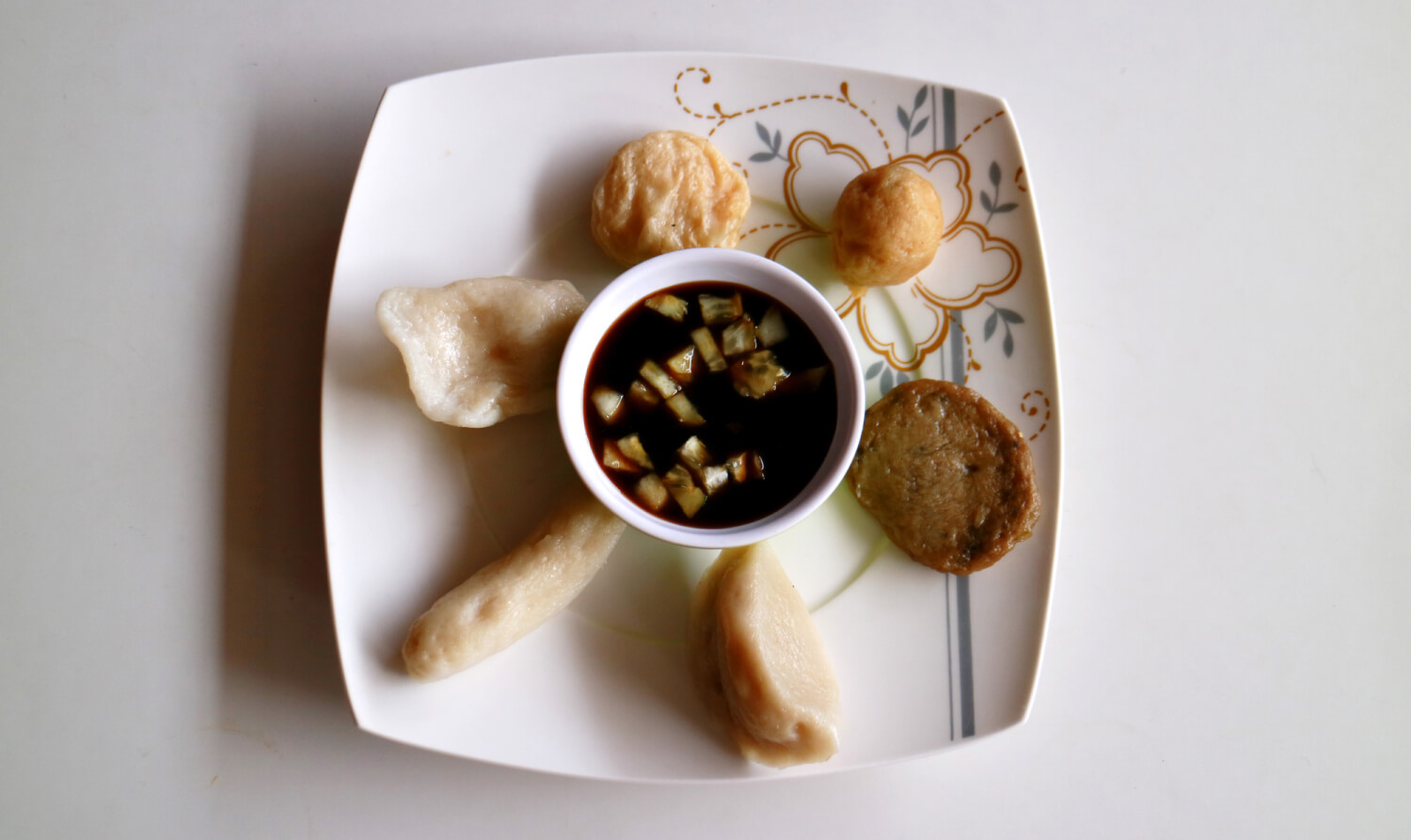
Tangyuan
Literally translated to “soup balls”, Tangyuan are a sweet Chinese dumpling dessert made up of rice flour balls, often dressed up with sweet fillings like sesame/red bean paste, or otherwise consumed in plain, but satisfyingly chewy bites.
Again, while the exact preparation of Tangyuan varies by region and even household, they are most commonly prepared either deep fried or in a sweet syrupy broth. Unsurprisingly, these decadent bites are popular celebration treats, consumed often during the Lunar New Year or at weddings.
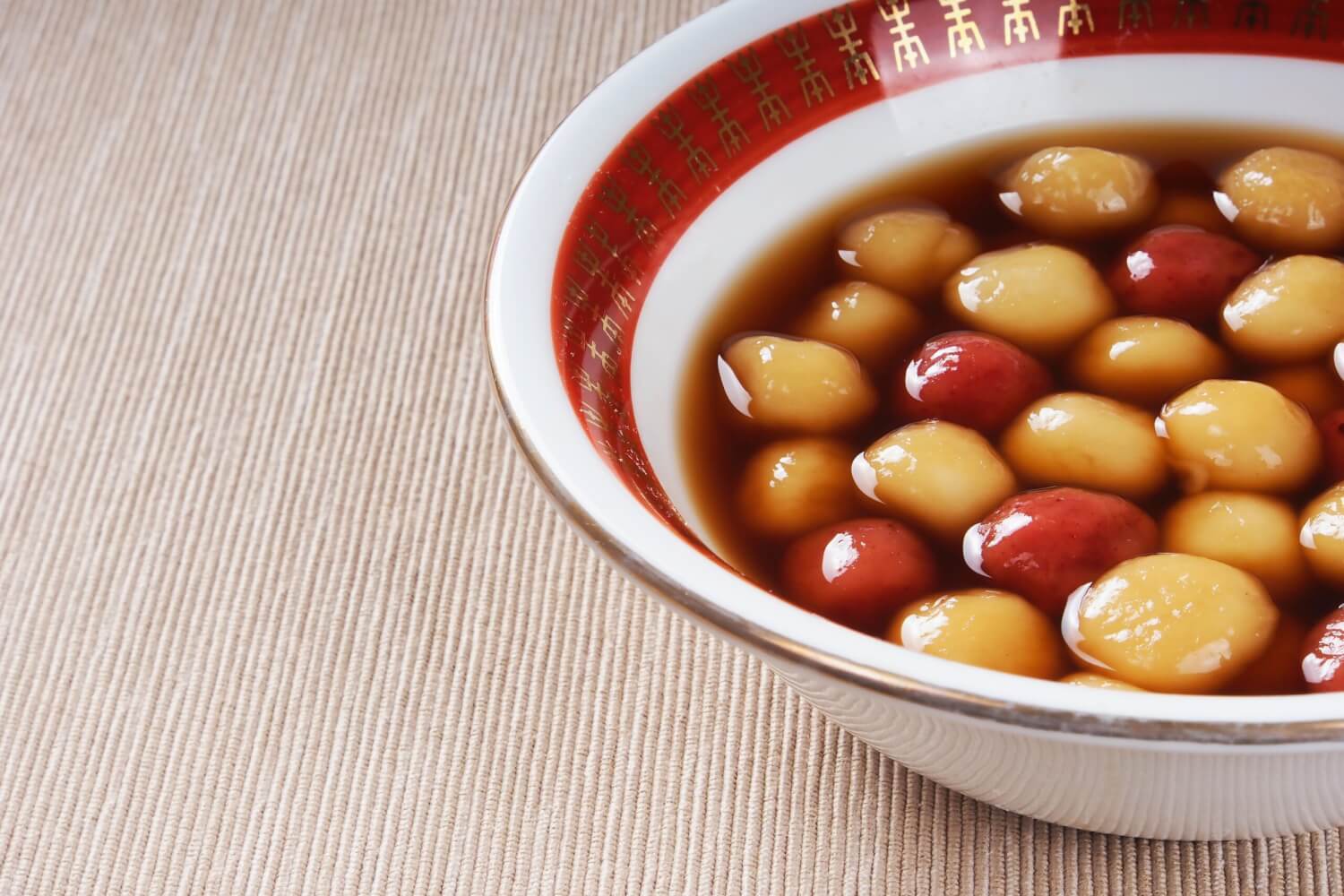
Delicious European Dumplings You Should Make Your Pierogi-tive
Of course, there’s a lot more to sample in the dumpling scene than just Asian dumplings. European dumpling variations are not just numerous, but delicious. Here are some of my top picks.
Pierogi
Of all the European dumplings you must try, I recommend making Pierogi the #1 priority on your list.
Alternatively spelled as “perogies” in North America, these Central European delights consist of dough pockets encasing tasty fillings including potato, cheese, ground meat, sauerkraut and (in dessert varieties) fruit.
My personal favourite is the classic Pierogi ruskie, filled with potatoes, onions and cheese… yielding simple, but perfect bites of perfection.
And while pierogi can be served either boiled or fried, I opt for a happy medium between the two – boiled pierogi with a few minutes sizzling in a pan. * chef’s kiss *
NOTE: For an extra cute mini-version, look into Uszka, small versions of pierogi often served with Borscht and on Christmas Eve in Poland.
Recommended reads:

Gnocchi
Italian food lovers will be no stranger to Gnocchi, petite Italian dough dumplings that perfectly pair with any sauce, cheese, or wine-filled Friday night.
The exact ingredients of gnocchi depend on where you are in Italy, but the most popular variations make use of potato, eggs, and flour in some combination as the base to create a dough that is then boiled and in tossed in yummy sauce.
These are a comforting and tasty dumpling you definitely need to try at least once in your life… then over and over and over because the possibilities are truly endless.
Recommended reads:
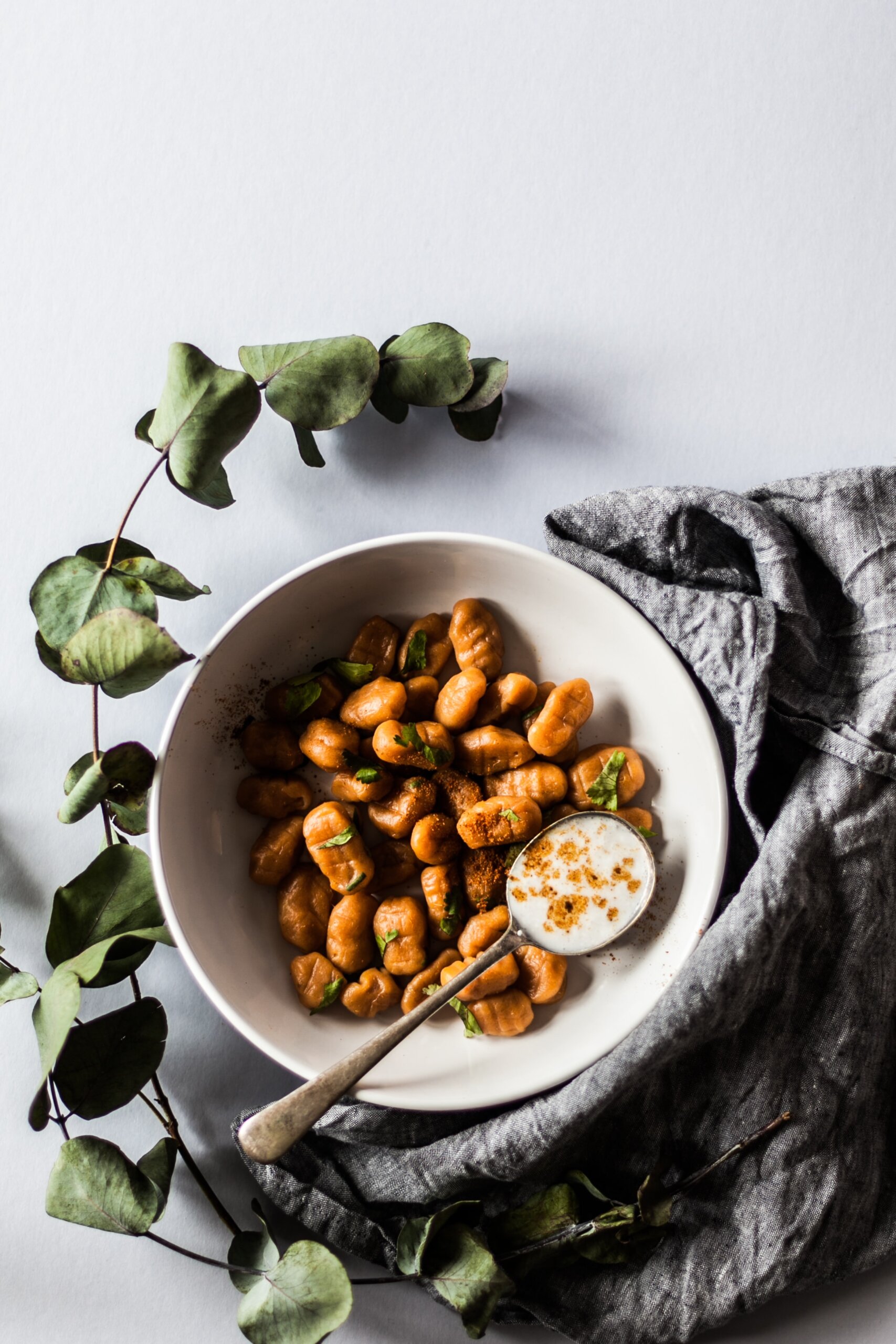
Halušky
Looking for another satisfying bite-sized dumpling? Look no farther than Halušky. Halušky are Slovakian potato dumplings consumed in vast amounts throughout Eastern Europe, similar to Italian gnocchi or German spätzle.
Often served with sheep’s cheese and bacon (in a dish known as Bryndzové halušky), some consider this to be the national dish of Slovakia… and what a mighty national dish it is indeed!

Idrijski žlikrofi
The Slovenian Idrijski žlikrofi is a wonderful savoury dumpling from east Slovenia known for its distinctive hat-like shape and tasty potato filling.
Commonly served as a side dish with a meaty main course or simply tossed in a meat sauce with breadcrumbs on top, these beloved Slovenian gems are a must-try for dumpling and pasta lovers. Did I mention how adorable they are….? I mean just look at them!

Khinkali
Khinkali are tasty soup-filled dumplings from Georgia that share similarities with the famous Chinese Xiao Long Bao, but differ a lot in the way they’re served and eaten.
Khinkali (typically filled with a ground meat filling) are meant to be boiled, seasoned lightly with ground pepper, then eaten by hand while grabbing onto their thick stem.
Strategically, this affords eaters a first bite to drain the soup out before going in for the kill.
Even more fun? The stems are traditionally left uneaten so you can keep track of your dumpling count. Yup – no hiding your shame here.
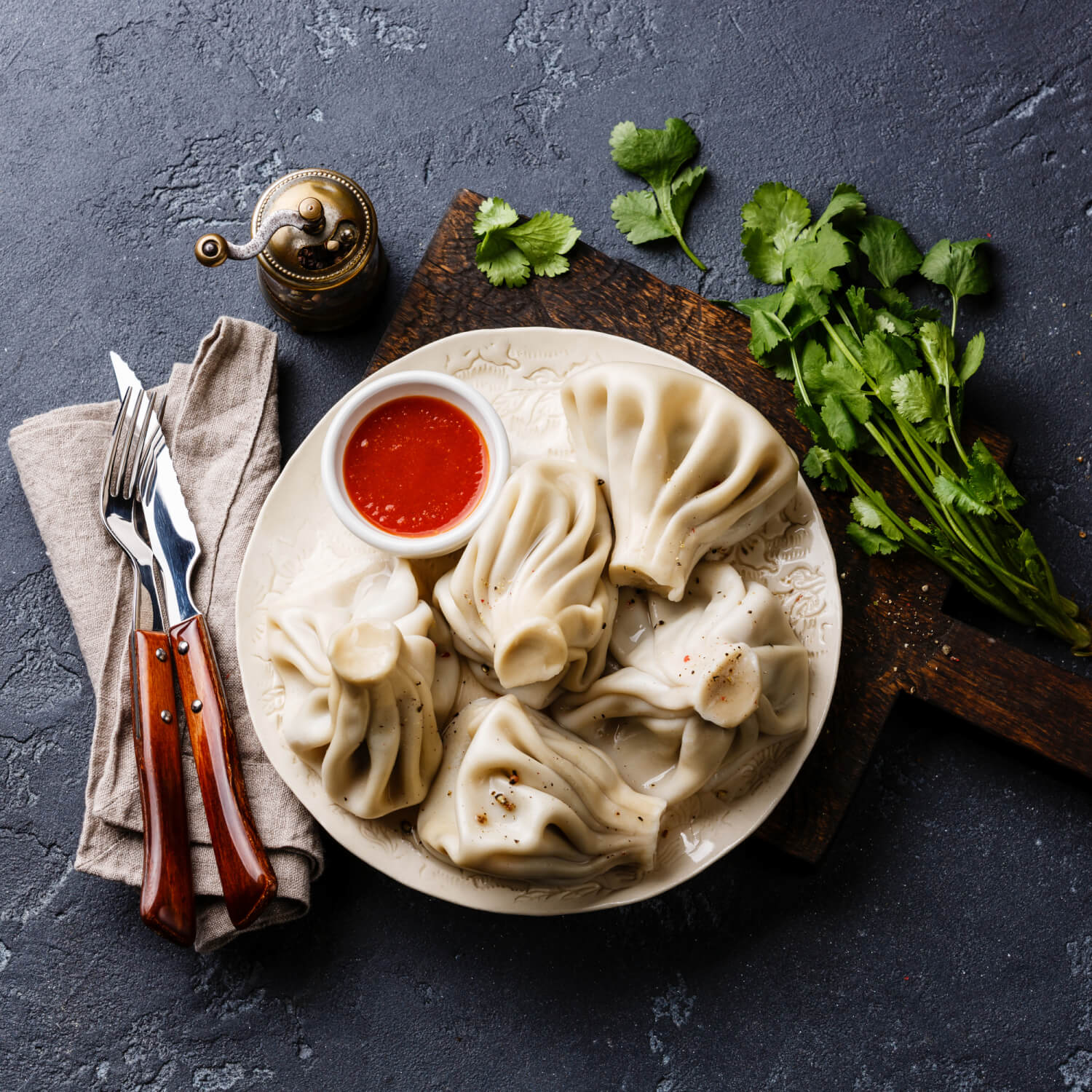
Ravioli
Odds are you have heard of Italian Ravioli before or even consumed it by the bucketload yourself, but if you think about it, Ravioli really are the perfect dumpling too, in addition to being a staple of the pasta world.
So what are they? Well, Ravioli is a broad term that encapsulates many kinds of stuffed pasta where you’ll find some kind of tasty filling encased in a thin pasta dough. Of course, Ravioli is tackled differently depending on where you are in Italy, with a lot of different types to taste and sample. More often than not though, ravioli is served in a tasty sauce or broth. Here are some types to keep an eye out for:
- Agnolotti: A type of ravioli from Piedmont, usually filled with veggies or meat and served in a broth or light sauce
- Tortellini: Little thumb-sized pasta packets from the Emilia Romagna region of Italy filled with a mix of meat and cheese. Shaped like bellybuttons and conventionally served in broth
- Tortellloni: Tortellini’s larger sister, traditionally stuffed with ricotta and served with a simple butter/sage sauce
Fun fact: In Italy, Chinese dumplings like jiaozi are often referred to as “Chinese ravioli”.
Recommended reads:
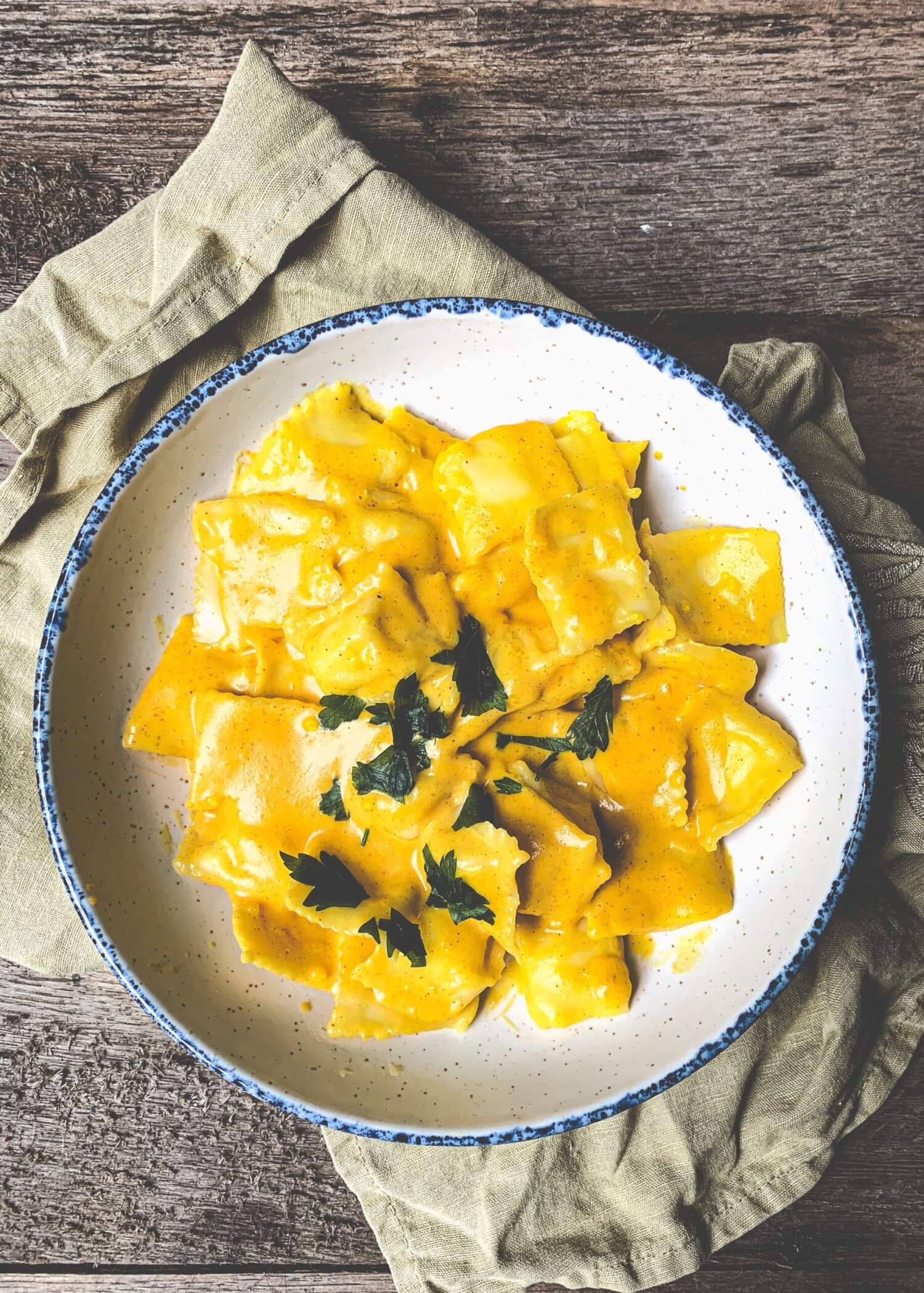
Knödel
Knödel are jiggly and wonderful spherical dumplings popular across central Europe and especially in Germany, where potato varieties (Kartoffelkloß) and bread varieties (Semmelkloß) are beloved side dishes frequently served in a pool of tasty sauce.
These boiled dumplings take on a lot of regional variety across Europe, and have both sweet and savoury serving options, but one thing’s for sure: no matter how they’re served, they are darn delicious.

Kroppkaka
For a Nordic twist on Knödel, give Kroppkaka a try!
Kroppkaka (besides being a DELIGHTFUL word to say out loud) are Swedish potato-based dumplings that are usually served boiled with an onion/pork filling and a generous slathering of butter, sour cream or lingonberry jam on top. That’s right… this dumpling is a chance to bust out the lingonberry. Anyone else getting wonderful IKEA food court flashbacks?

Knedle
Knedle are Eastern European potato-plum dumplings that are the ultimate comfort food and dessert rolled in one.
Comprised of an outer layer made of mashed potatoes and a sweet plum filling, all these flavours are beautifully enhanced by the final touch: generous toppings of sour cream or cinnamon.
As with all great things in life, more decadent versions also exist where the dumpling is liberally slathered in breadcrumbs and deep fried, but trust me, these tasty sweet dumplings are good no matter how you serve them.

Pelmeni
Pelmeni are a divine Russian creation consisting of little bites of minced meat wrapped with thin dough, best topped off with some sour cream or butter. This comfort food is simple, but addictive, and with their tiny size, deceptively easy to over-indulge…
PS: It’s worth noting that pelmeni and variations thereof are known by various names throughout Eastern Europe and Central Asia, such as Dushbara and Joshpara.

Cepelinai
Named after their distinctive, zeppelin-like shape, Cepelinai are a beloved Lithuanian dumpling made up of a ground meat filling and a squishy outside layer of riced potatoes.
These wonderful comfort foods vary in size and serving across the country, but are most commonly eaten with a simple side of sour cream and bacon bits.
They’re very similar to the Knödel discussed above, but worth a mention on their own thanks to their distinctive filling and serving style.
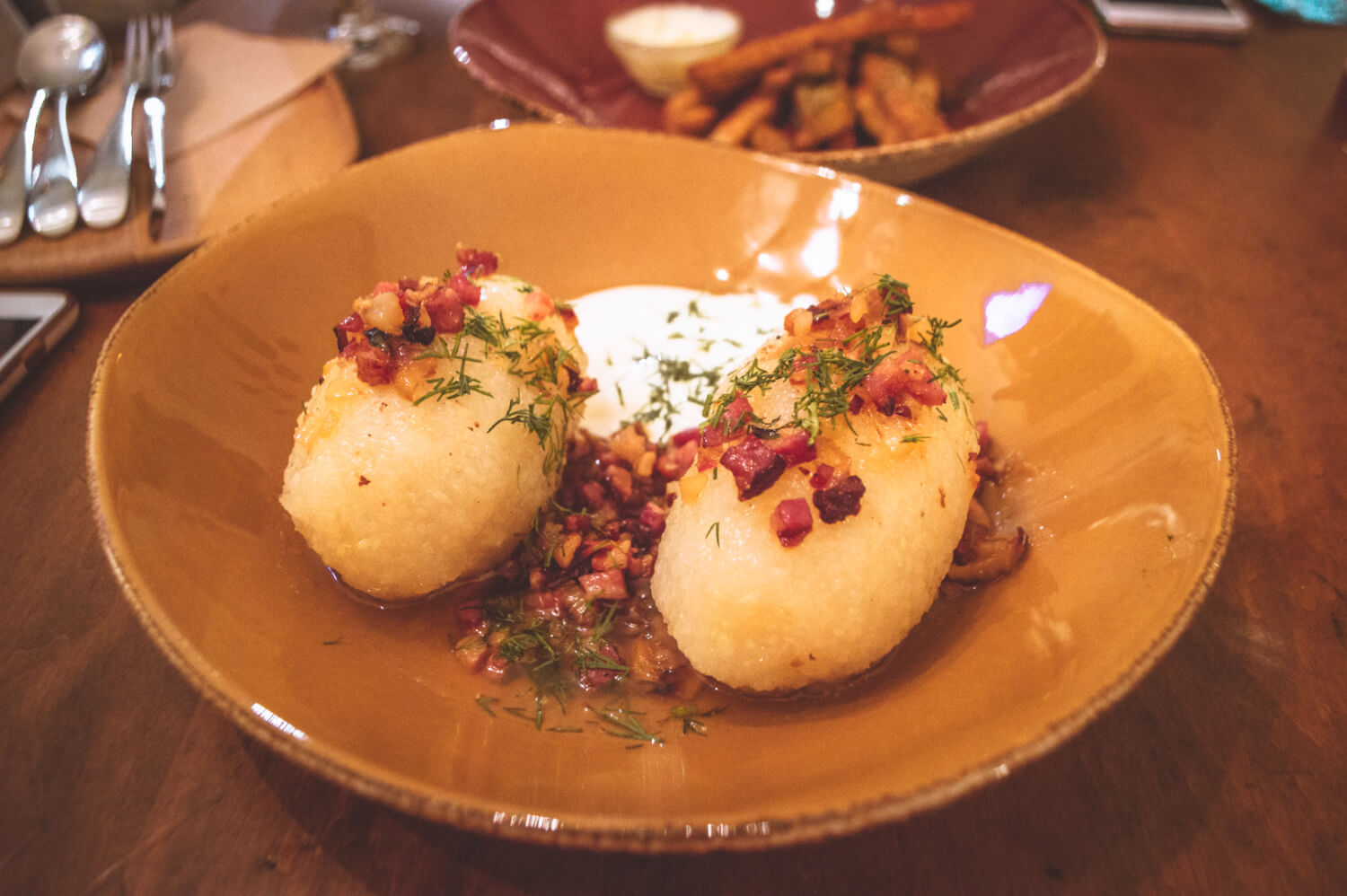
Chebureki
Consisting of fried dough with a seasoned meat filling, it’s not tough to see why Chebureki is such a popular Russian street food consumed throughout Eastern Europe and Central Asia.
Think of these flat, crescent-shaped dumplings as a savoury turnover, with various fillings including mutton, beef, onions, or pork, all packed into a slab of dough that’s fried or baked.
Thanks to their handy structure, they make the perfect on-the-go snack (ideal for stuffing into pockets, purses, or even your bra if you’re feeling adventurous. Kidding!! … Kind of)
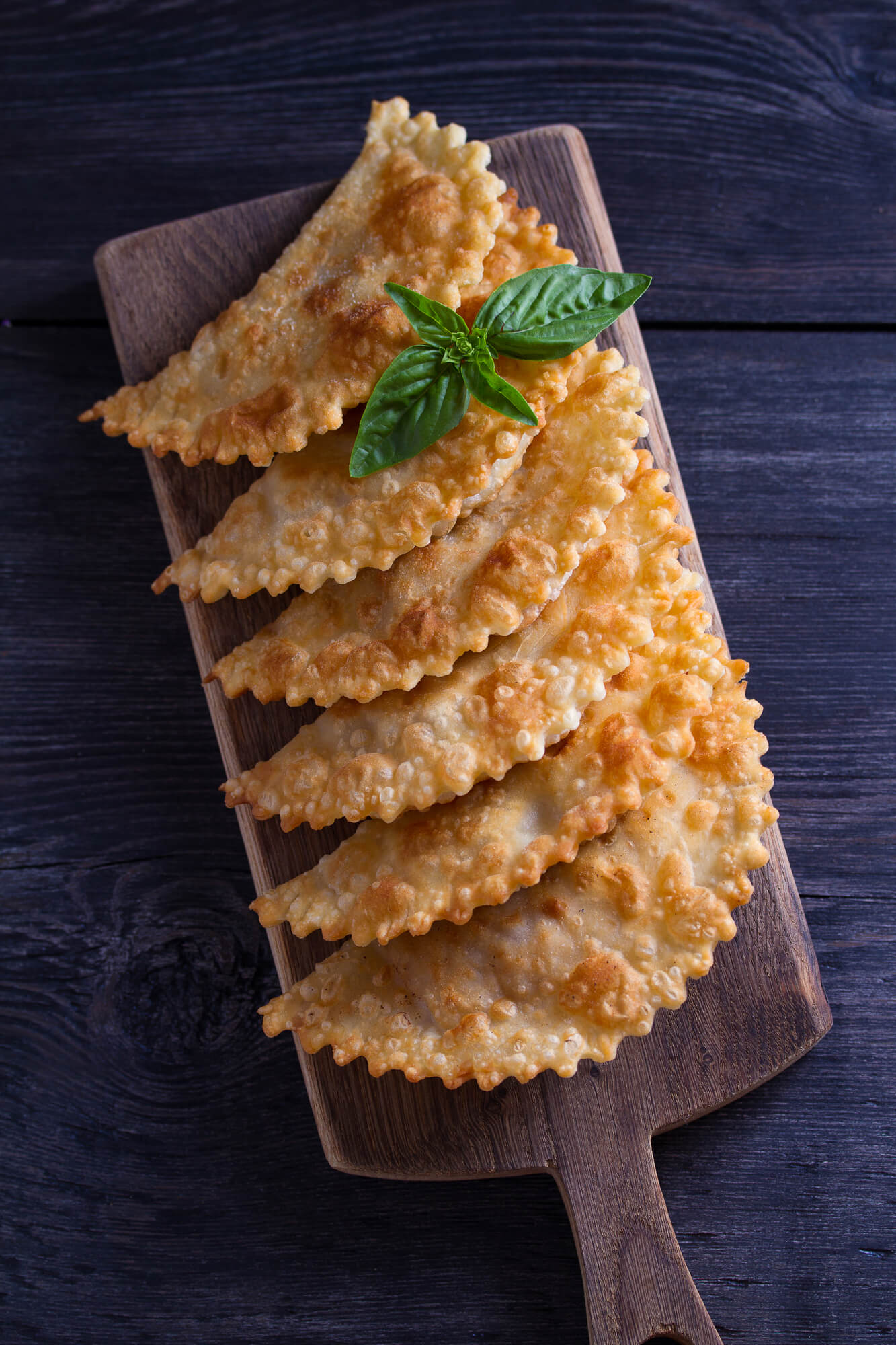
Maultasche
For something heartier and homier, be sure to try Maultasche, one of the best comfort foods that Germany has to offer.
Maultasche are delectable German dumplings from the Swabia region, with a pasta-like exterior housing a tasty filling made with ground meat, bread crumbs, various spices and spinach.
These rectangular pockets of wonder are similar to ravioli, but differ in that they’re much bigger and usually served in a clear broth… although saucy Maultasche are equally delicious.

Kopytka
The Polish potato dumplings known as Kopytka translate literally to “little hooves” thanks to their cute and distinctive hoof-like shape.
Made up of potatoes and flour, these versatile little dumplings are consumed in a myriad of ways, from savoury dishes filled with cheese, onion and bacon to more dessert-like servings with sweetened quark, butter, sugar, cinnamon, or sometimes even sour cream.
Their chameleon-like ability to complement so many different sauces and dishes is of course what makes them so irresistible. Plus they might be the cutest little dumplings on this list:
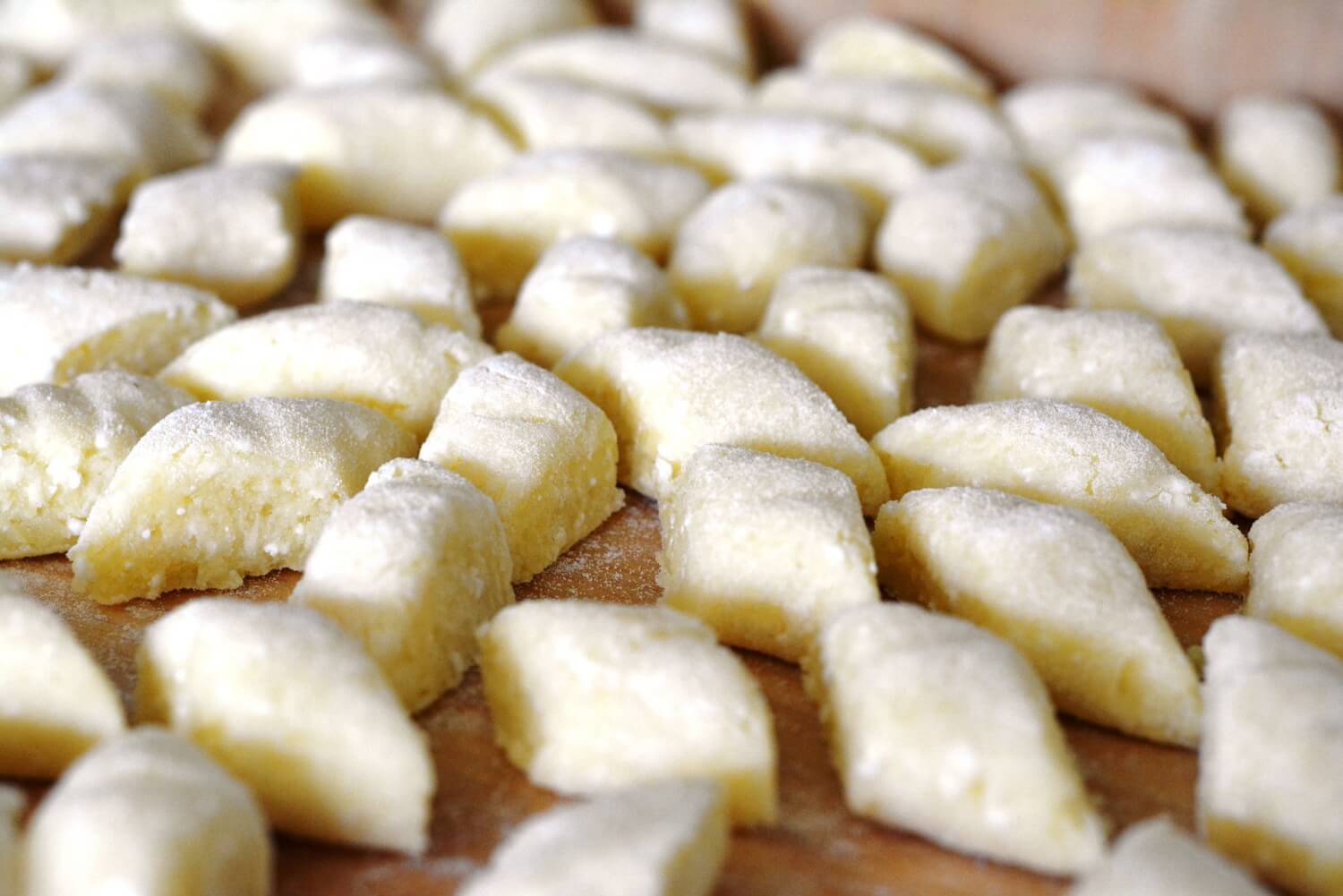
Cornish Pasty
Lastly, we have the almighty Cornish pasty.
I hesitated to include this one on the list because it’s really quite a mammoth thing and a smidge too large to really be “dumpling-esque”, BUT these baked golden pastry pockets are one of my favourite things to eat in the whole world, so I’m bending the rules a little bit.
Traditionally, Cornish pasties are filled with beef, potato, and onion, although these days all sorts of tasty fillings are possible. I’m a purist though, so I always go for the steak and potato. True fact: I literally cannot walk past a pasty stand without wanting one so England is a very dangerous place for me and my arteries.

Latin-American Dumplings That’ll Make You Feel Like You Empanada to Worry About
While dumplings aren’t as huge a part of Latin American cuisine as the regions mentioned above, there are still quite a few notable doughey creations you should take note of. Here are a few, if you haven’t already left yet from that horrific header pun.
Empanadas
Similar to pasties, Empanadas aren’t often considered dumplings, but I’m including them in this list because a) they are delicious must-tries and b) they’re dough filled with stuff, which more than satisfies my definition of dumpling! Appearing in dizzying variations across Latin America, empanadas are essentially pastry/dough pockets stuffed with savoury fillings that are then fried or baked to create a perfectly crispy crust.
NOTE: Besides being tasty, they are also visually stunning and very satisfying to stare at:

Chapalele
Chapalele, also referred to as Chilean potato bread, are versatile potato and wheat flour dumplings from Chile, with both sweet and savoury variations that you can try!
Particularly popular in Chiloé cuisine from southern Chile, these flat disk-like dumplings are popular served with chicharrones (pork rinds), honey (for a dessert-y option) or simply on their own as a little snack. Mm!
Pantruca
Pantrucas are tasty little Chilean dumplings that are essentially blobs of floury dough cut up and served in broth. This is one of the most prototypical comfort foods in Chile, and the perfect dumpling dish to try on a cold day!

Canadian & American Dumplings that’ll make USA “Yum!”
The culturally diverse landscape of both the US and Canada have made them the ideal breeding ground for new recipes, cuisine types, and even dumpling creations. Here are a few unique dumplings to try that are popular in North America!
Chicken and Dumplings
Chicken and dumplings are considered by many to be the ultimate comfort food, and if you’ve ever bitten into a doughy broth-soaked dumpling on a cold winter day, you might be inclined to agree.
Commonly consumed throughout the US, especially in the South, Chicken and Dumplings is a classic dish is made up of tasty chicken simmered in broth, with tender biscuit pieces (the “dumplings”) to soak in the savoury goodness.
Take one look at the photo below and try not to drool.
Recommended Reads:
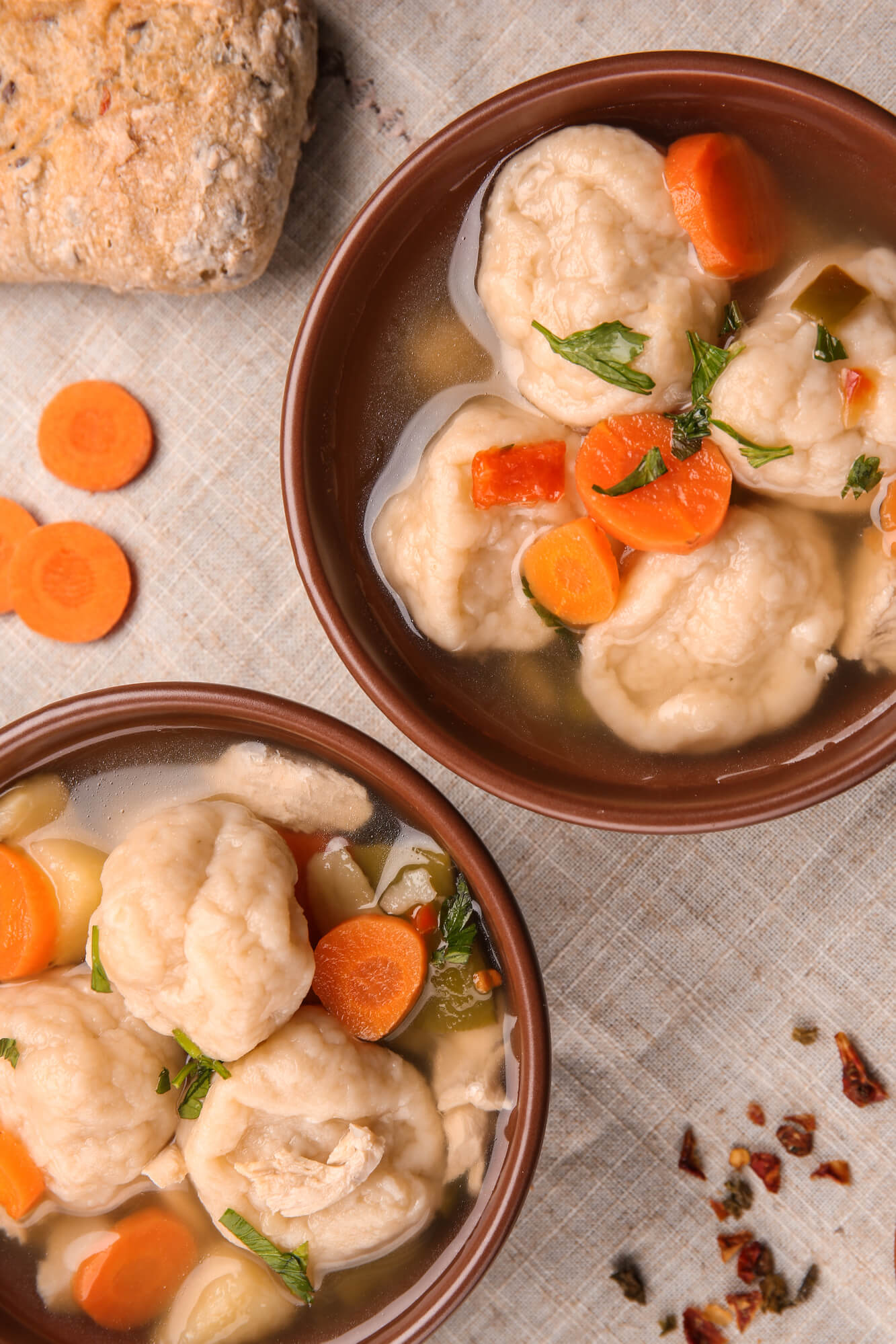
Apple Dumplings
It’s a simple dessert that is enjoyed in various forms around the world, but Apple Dumplings (consisting of apple wrapped in pastry) are one of those perfect comfort foods that hit the spot while still masquerading as mildly healthy thanks to the apple’s starring role.
Some recipes call for baking the dumplings and adding a nice spiced sauce over top, while others go for the more low-key boiling method. Regardless of how they’re prepared, apple dumplings are a happy cousin of the apple pie that are well worth a spot on your dumpling bucket list!
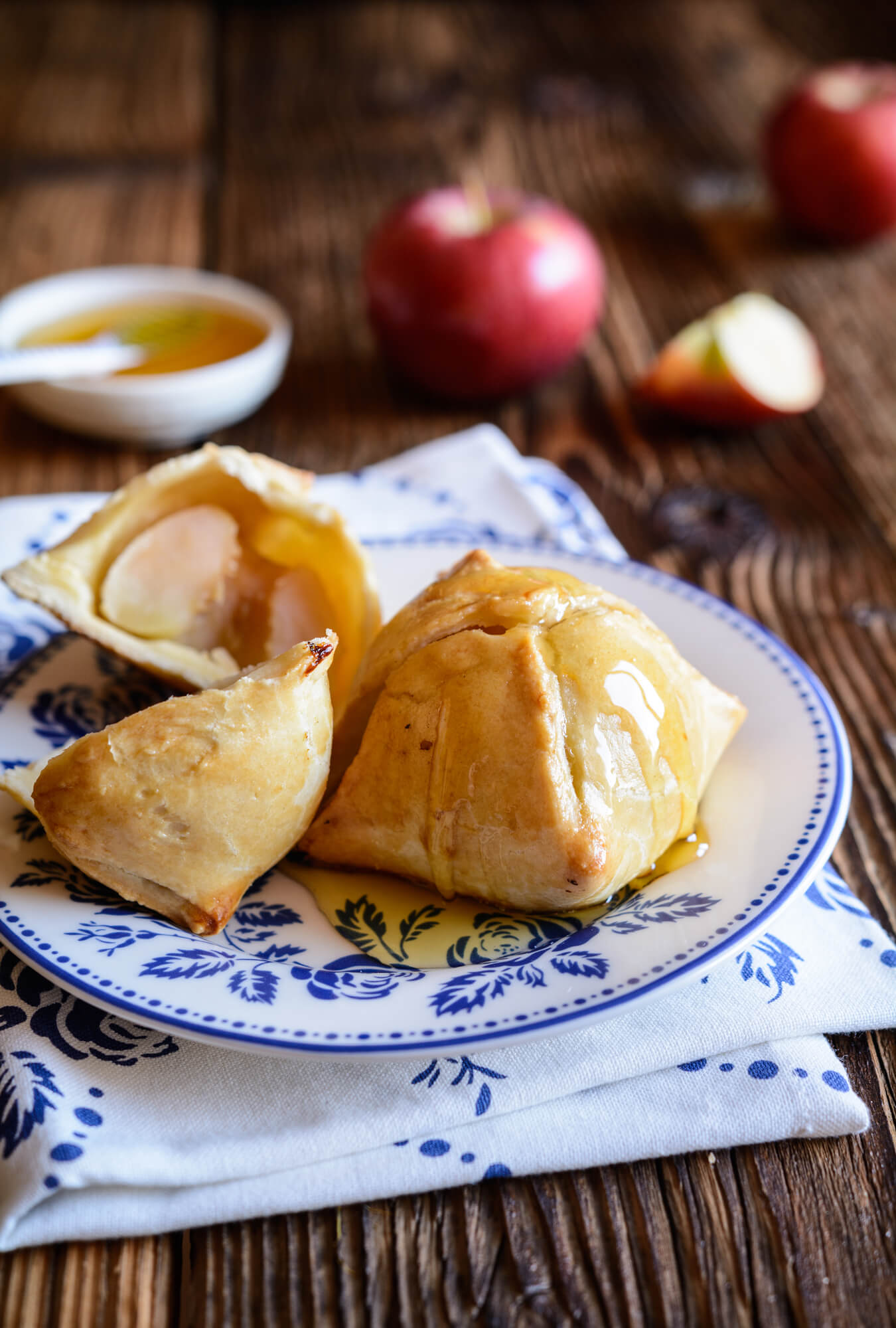
Poutine Rapee
For a classic Acadian comfort food, look no further than Poutine Râpée, a boiled potato dumpling with a pork filling (not to be confused with the classic Canadian drunk food poutine, which is made up of fries, cheese curds and gravy).
The Poutine Râpée has a wonderfully squishy texture thanks to its outer layer of grated/mashed potato, much like European Knödels.
Where it wins however is its versatile taste and serving style, which works well both savoury (with salt and pepper) and sweet (with molasses, maple syrup, brown sugar, etc.).
Crab Rangoon
Although a popular appetizer at many Asian restaurants in North America, the murky origin stories of Crab Rangoon (deep fried wontons wontons filled with cream cheese, crab, onions, and garlic) all seem to suggest that these indulgent dumplings are not actually Asian in origin, but more likely an American creation… after all, cream cheese is a starring ingredient, so you do the math.
Love or hate the concept, it’s a popular guilty pleasure and a staple of Americanized-Chinese cuisine, so definitely a must try for your dumpling bucket list.
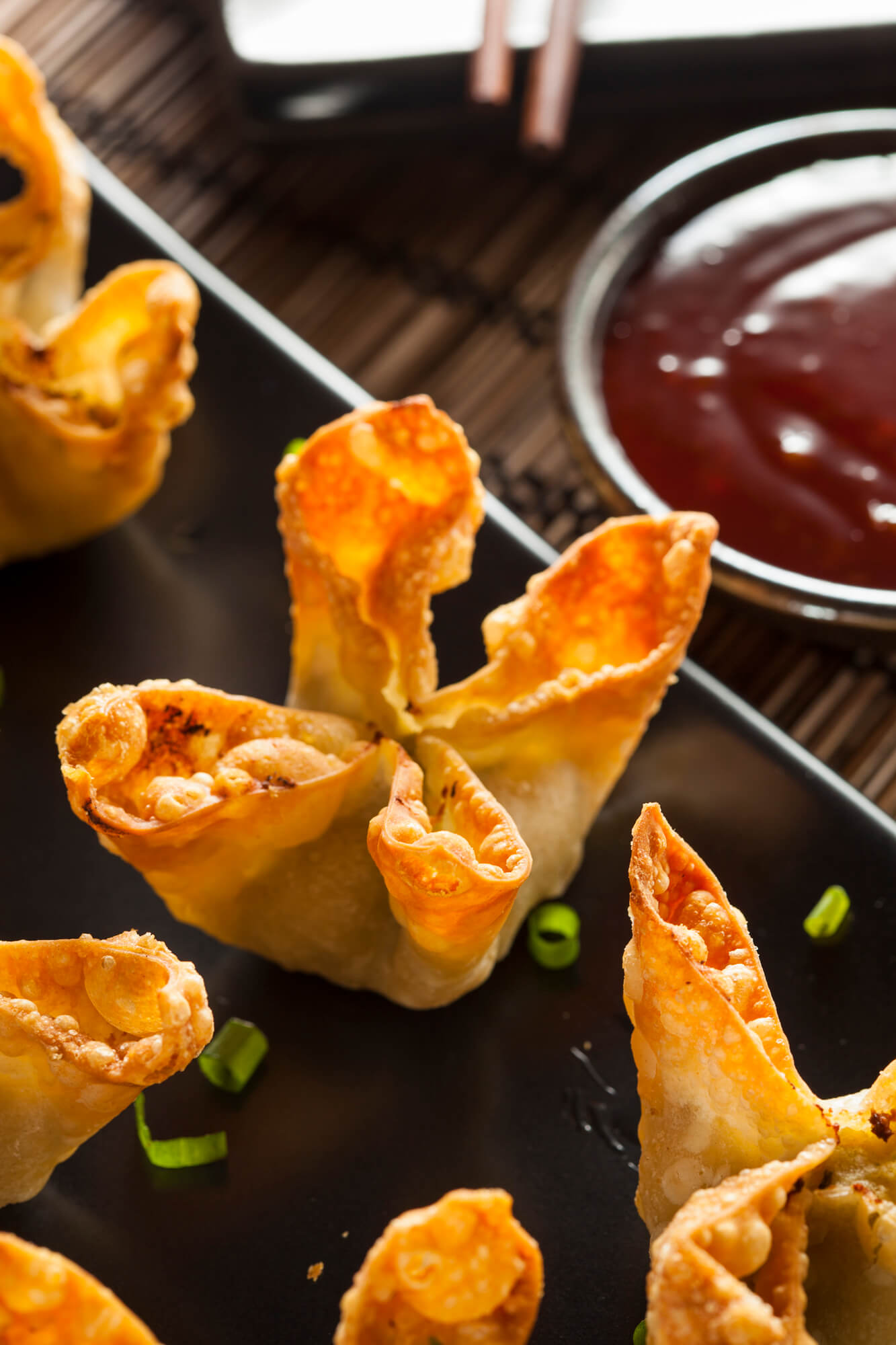
A Roundup of Middle Eastern Dumplings that Israel-i Gonna Make You Hungry
Middle Eastern dumplings? Yes please. Here are some tasty ones to try:
Manti
While Manti is a dumpling with many variations across cultures (particularly in the Caucasus, Eastern Europe, and Central Asia), the bite-sized versions popular in Turkey may be my favourite.
Served with a garlicky yogurt sauce and spice-infused oil, these little packets of spiced meat/onion are absolutely irresistible. Similar variations are also consumed in Afghanistan, Armenia and Lebanon among others. In Lebanon, a popular lamb-filled dumpling similar to Manti is known as Shish Barak.
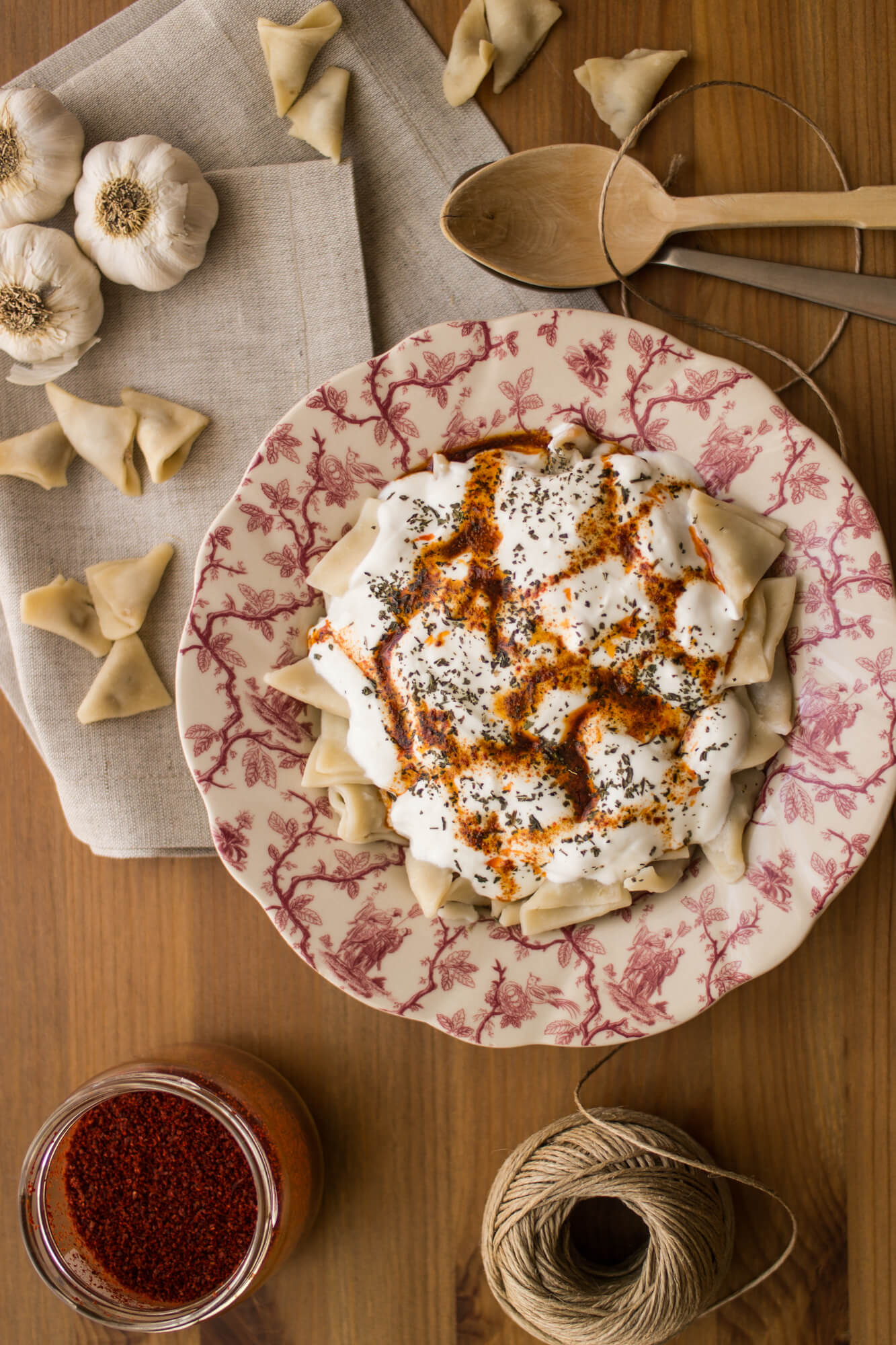
Kubbeh
Known by many names and spellings (including Kibbeh and Kubba), Kubbeh are Middle Eastern dumplings made typically from a bulgur wrapping with spiced meat awaiting inside.
Thanks to its dizzying regional variations however, you can try kubbeh shaped like disks, molded into football-esque shapes, or even with a ricey ctust.
The beauty of Kubbeh is its versatility – whether served in yogurt, lemon sauce, deep-fried or swimming in broth. Maybe to appreciate them, you’ll need to try them all, am I right?
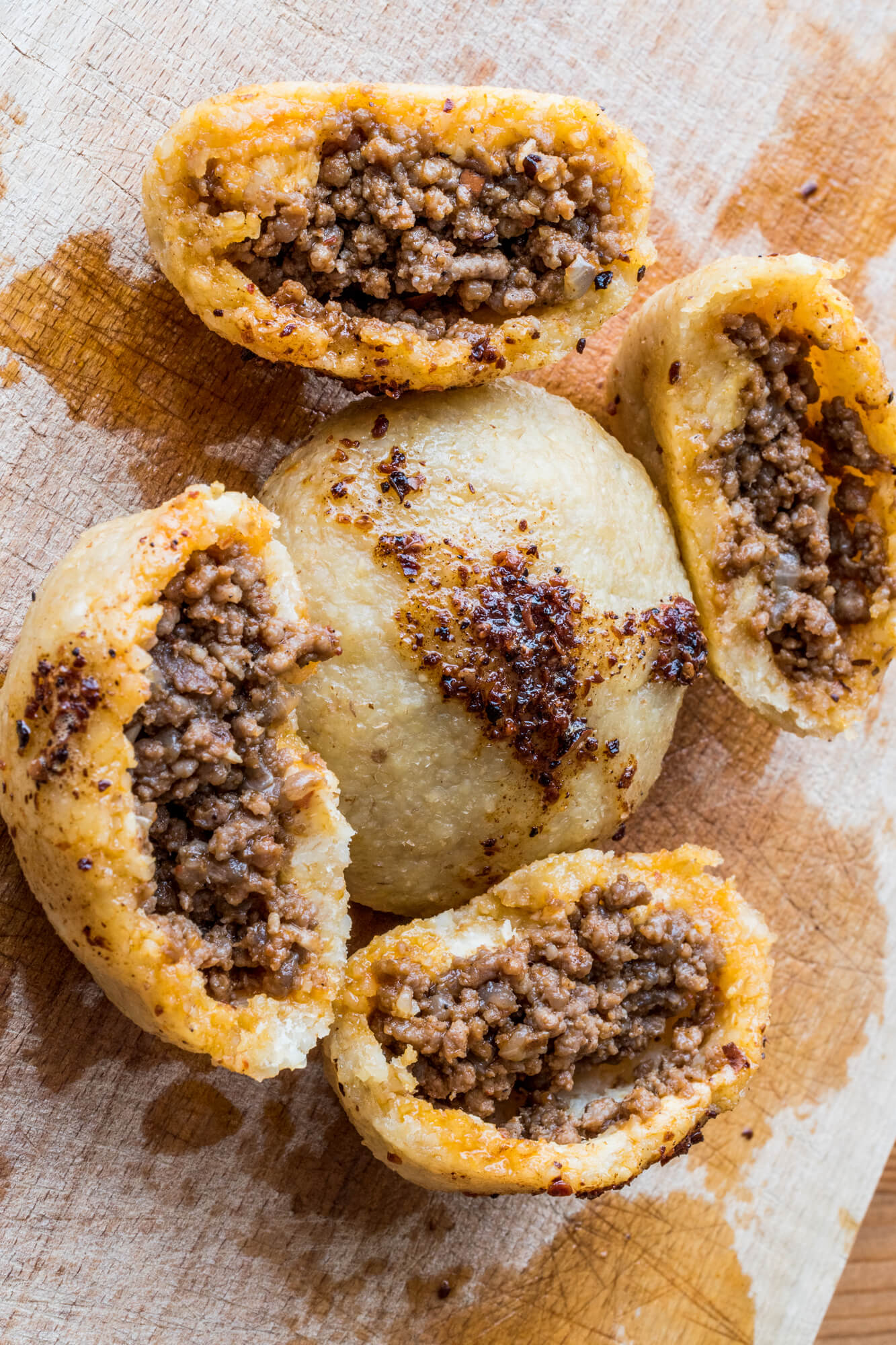
Luqaimat
For a treat that’s both crunchy and sweet, be sure to try Luqaimat, a dessert dumpling that’s beloved all over by different names (including Awameh and Lokma). No matter what you call them though, these tasty dumplings are essentially deep fried donut balls slathered in syrup or honey to create a perfect bite-sized bit of indulgence. Commonly served with Arabic coffee or an unsweetened tea, these are some of the most irresistible sweet dumplings in the world.
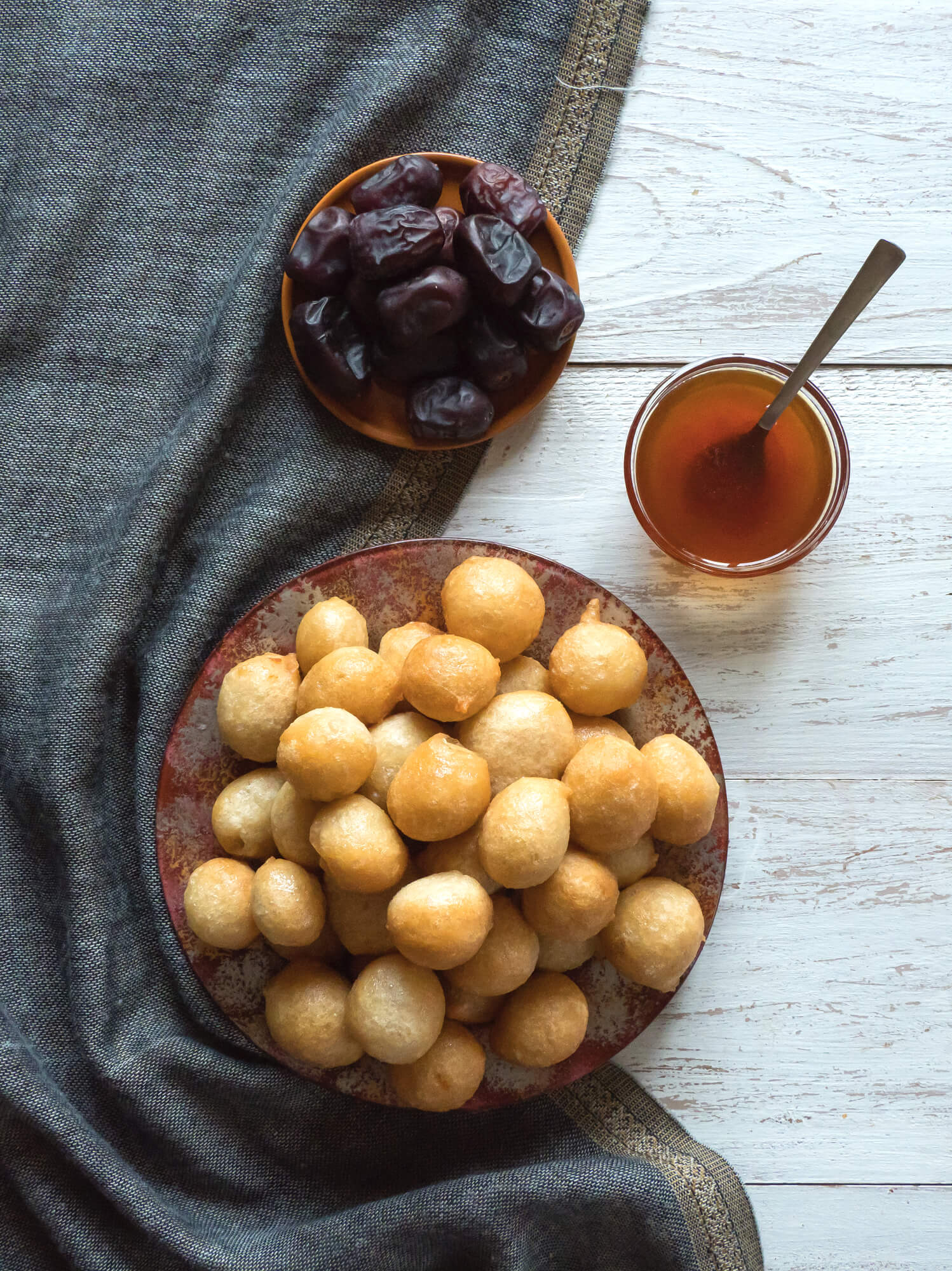
Yummy Jewish Dumplings that Jewish You Could Eat Right Now
While not the conventional filled dumplings we see in Asian or European cuisine, there are many beloved dough creations in Jewish food culture that we couldn’t omit from this list of worldwide dumplings. Here are a few to try:
Gondi
Gondi are a Persian-Jewish creation consisting of spherical dumplings made of ground meat and chickpea flour, along with spices and onions for flavour.
Most commonly served with chicken soup for Shabbat and special holidays, this is one tasty dumpling you definitely need to try!
Kreplach
Kreplach are bite-sized dumplings usually served in chicken soup with all sorts of tasty savoury fillings including meat or mashed potatoes.
These often triangular-shaped dumplings are a common dish served for religious occasions, such as Purim and Yom Kippur, and carry their hefty share of symbolism.
For instance, the Kreplach’s triangular shape is said to represent Judaism’s three patriarchs: Abraham, Isaac, and Jacob.
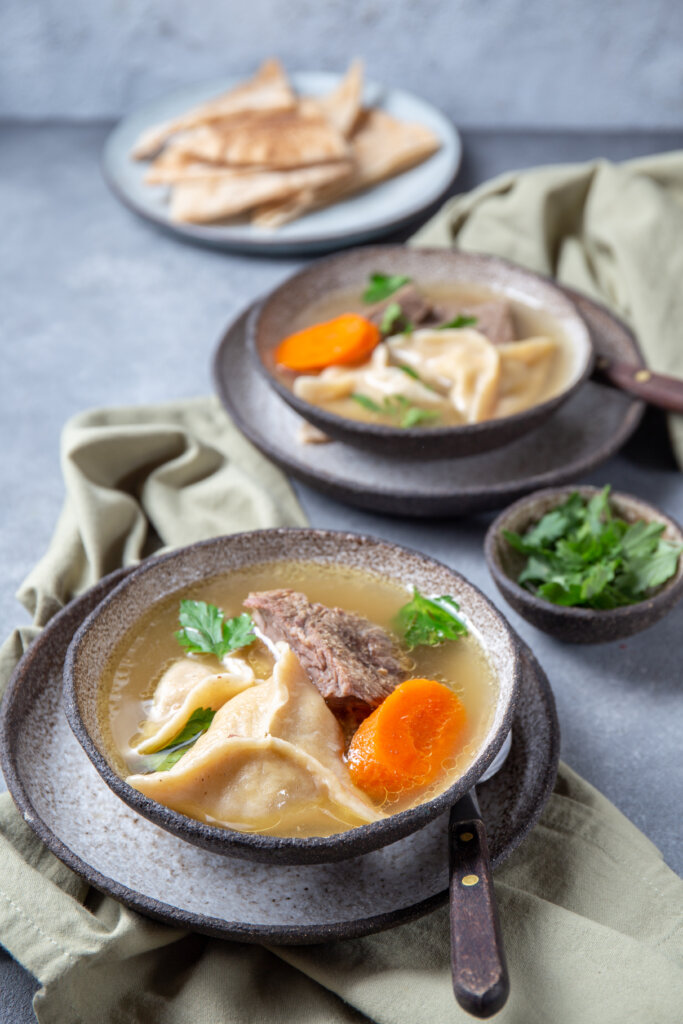
Matzah Ball
Matzah balls are a tasty Jewish soup dumpling that require no introduction.
Made by mixing eggs, matzah meal and fat (of course), these fluffy dumplings are a popular food consumed during Passover, especially in Matzo Ball soup, when the dumplings are combined with perfectly simmered chicken broth.

Shlishkes
Lastly, we have Shlishkes. Shlishkes are little potato dumplings that are similar to gnocchi except with one important distinction: these bad boys are not just boiled – they’re deep fried with a nice bread crumb coating. Mmm mm.
African Dumplings that are A-frican’ Treat to Eat
Last but not least, let’s round off this list of global dumplings with a selection of tasty dumplings from Africa. Enjoy!
Tihlo
Tihlo are little dough dumplings that originate from Ethiopia, made from barley flour mixed with water to create tiny dough balls that are subsequently dunked in a spicy meat sauce.
Said to be a a common staple at weddings, these little dumplings are often paired with tej, an Ethiopian honey-wine.
Souskluitjies
Souskluitjies are South African dessert dumplings made up of light dough pieces boiled in water, then doused in butter, cinnamon, and sugar.
I know – what more could you ask for?
Known as a childhood favourite for many, this nostalgic treat is definitely one you need to try.
Dombolo
Dombolo are steamed bread dumplings made from flour and yeast that offer the perfect cozy touch to various soups, stews and sauces.
Thanks to their fluffy bread-like texture, they also make the perfect tool for sopping up delicious leftovers!
Banku
Hailing from Ghana, Banku are sticky, sour dumplings made from fermented corn and cassava, usually served with soup or paired with seafood.
They may not be the most photogenic dumplings on this list, but they’re considered to be one of the national dishes of Ghana, making them a must-try!

Kenkey
Very similar to Banku are Kenkey, sour dumplings commonly consumed in West Africa and parts of Latin America and the Caribbean.
While like Banku, Kenkey is made of fermented maize, it differs slightly in preparation (depending on where you’re enjoying it!) Most often, Kenkey is cooked only partially before it’s wrapped in some banana leaves/foil, then steamed.

Did I miss any of your favourite dumplings?
Let me know in the comments below! I hope you enjoyed taking this worldwide tour of tasty dumplings with me today. Bon appétit!

uncrustables are dumplings fight me
no need to fight. we totally agree!